[ad_1]
People may know Indonesia as a country with diverse and beautiful natural landscapes such as Bali, Komodo Island, and others. But did you know that Indonesia is a multicultural country? With a population of over 275 million, Indonesia has more than 300 ethnic groups. One of the most distinctive cultures in Indonesia is Torajan, an ethnic group from Toraja, a mountainous regency in South Sulawesi, Indonesia. This means that Indonesia not only has magnificent natural attractions, which are great for hiking and diving, but also a diverse culture that makes Indonesia worth a trip.
I visited Toraja as my first solo trip destination because, amongst the Indonesian, Toraja is also quite an anti-mainstream travel destination. Once I stepped foot there, I realize I have never felt this kind of atmosphere in any place, even in Indonesia. The thick cultural presence, surrounded by distinctive traditional architecture and ornament, is something I have never seen in any other part of Indonesia. These factors made my trip experience in Toraja so unique that you should definitely visit Toraja as well.
Why Visit Toraja?
There are three reasons why you must visit Toraja when you come to Indonesia.
1. Distinctive Culture
The first and most major reason is their distinctive culture. Among all of the cultures in Indonesia, Toraja is well-known for the way it treats and respects death, which is translated into its uncommon funeral traditions. This includes ceremonies called Rambu Solo and Manene. Beyond the ceremonies, Toraja has lots of unique architecture and several sacred burial sites that you may not encounter in any other part of Indonesia.
2. Magnificient Nature
The second reason you should visit Toraja is the nature. Toraja has a lot of magnificent natural attractions as the region is located in the mountainous area of South Sulawesi. Between the hill viewpoint, rice fields, and waterfalls, you will have a variety of choices to enjoy mother nature. Moreover, I recommend you to visit any hill viewpoint in Toraja as it is a great sunrise and sunset viewing spot.
3. Torajan Coffee
The third reason to visit Toraja is the coffee. Another advantage of being located in the highland, Toraja has a lot of coffee plantations. Among the many types of coffee in Indonesia, Torajan coffee is the most well-known coffee globally, with a unique, rich, and deep flavor. So, visiting Toraja will give you the best coffee-drinking experience Indonesia has to offer.
A Little Bit About Torajan Ceremonies
There are several ceremonies in Toraja, but the most famous ones are Rambu Solo and Manene. Rambus Solo is a ceremony conducted during the funeral process. Before Rambu Solo is conducted, the dead person is still considered a normal sick person, which means the funeral process can’t be executed. In the process of the Rambu Solo ceremony, a sacrifice is also needed. Locals will spend a lot of money for this sacrifice, usually in the form of pigs or buffalos in enormous amounts (as little as 10, but up to hundreds!).
The type of animal purchased for sacrifice also determines how much money locals need to spend for the ceremony. There is a rare pink buffalo with black patches, which is the most expensive buffalo among them all. Typically, the rarer and more expensive animals are purchased for aristocrats and other important people in Toraja, as not everyone can afford these sacrifices. This ceremony is open to the public, so you can see this exceptional tradition.
Different from Rambu Solo, Manene is used to change the clothes and coffin of the corpse. The unique thing about this ceremony is the walking corpse, which locals believe is controlled by a mystical power.
How to Go to Toraja?
To get to Toraja, you first need to find your way to Makassar, the capital city of South Sulawesi Province. There are several daily flights to Makassar from Jakarta or Bali.
After you reach Makassar, there are two transportation modes that you can use to reach Toraja. But, the easiest and most common method is by bus. The bus runs two times per day from Makassar to Toraja and it takes around 6-7 hours for a one-way trip. I suggest you pick a night bus to save on your accommodation expenses, especially for a budget traveller. Moreover, this bus has an almost 180-degree reclining chair and blanket which ensures you can travel and rest comfortably. The bus will stop at two towns in Toraja, Makale in the south, and Rantepao as the final stop in the north. For a one-way trip, the bus ride will cost around 7-10 US dollars per person.
Another travel option is to use a plane. However, flights can be infrequent, and the price is four times more expensive than the bus. However, flying is the quickest way to reach Toraja, as it takes less than an hour to reach Toraja from Makassar.
When is the Best Time to Visit Toraja?
Indonesia generally has two seasons, a wet season from November to March, and a dry season from April to October. The best time to visit the majority area of Indonesia is during the dry season. However, I would say the best time to visit Toraja is in July or August. During these months, you will have a higher chance to see the Rambu Solo ritual. You can ask for tourism information there to gather information about which family is holding the ceremony and also the location where the Rambu Solo ceremony is being conducted.
Things to Know Before Visiting Toraja
- Most places in Toraja still use cash payments. It’s best for you to take cash out as soon as you arrive at the airport, or after you arrive in Makassar. There are only a few ATMs in Toraja, so you may have a hard time finding one once you’re already there. To use your phone on the trip, a Telkomsel SIM Card will give you better coverage in Toraja. You can buy it at the airport when you arrive in Makassar.
- Toraja is very safe. I accidentally left my motor key hung on the motor while I’m taking a nap for a couple of hours (Please don’t do this). Fortunately, nobody stole the motor while I was asleep. Even locals there admit it’s pretty safe and there are few thievery cases. However, you should still be extra cautious anywhere you are not familiar with. As I mentioned before, there are two major towns in Toraja, Rantepao, and Makale. I recommended staying in Rantepao because most hotels, homestays, and attractions are in this area.
- Please respect the local traditions. This includes not touching or moving the position of any skeleton in the gravesite. Otherwise, you will get a local punishment.
Things to Do in Toraja for 2 Days
For visiting the main attractions in Toraja, I would say 2-3 days is enough to explore it in its entirety. Here is an itinerary of things you can do in Toraja over 2 days.
Day 1
Buntu Burake
Located in Makale, South Toraja, Buntu Burake has the tallest Christ the Redeemer Statue in Indonesia. This 45-meter statue stands tall on the hill of Makale with an altitude of 900 meters. For me, the height of this hill is a great place to enjoy a nice view of Toraja.
I came to the statue at 6:30 AM and nobody was there at that time. I really loved spending my time there that morning because I could also see the moment when the town of Makale was shrouded by a cloud layer below your eye level. For me, this was a magical moment that I won’t forget from this place.

If you visit Buntu Burake, I advise that you park your vehicle in the parking area at the top of the hill. Most people will park at the main entrance gate which is located at the bottom part of the hill. Unless you are extremely fit, you need to be tough to conquer the 7,700 steps to reach the Christ Redeemer Statue from the main entrance.
There is also a glass bridge on Buntu Burake that you can access and walk across if you have enough courage.
Kete Kesu Village
If you visit Toraja, you definitely can’t skip the Kete Kesu, which is an iconic landmark of Toraja itself. If you type “Toraja” in Google Images, most of the pictures at the top of your search results would be the iconic view of Kete Kesu.
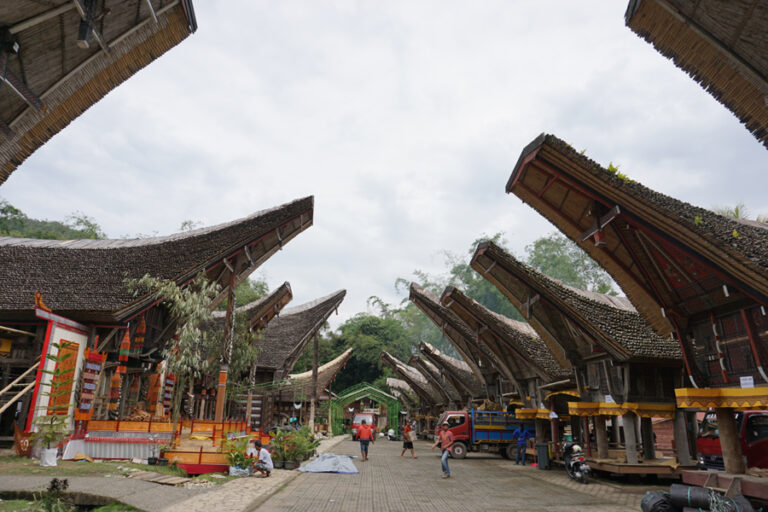
Kete Kesu is a well-known burial site in Toraja, as well as the centre of the cultural ceremonies that take place, like Rambu Solo. Once you enter the complex of Kete Kesu, you will arrive in the plaza, surrounded by Toraja’s boat-shaped traditional houses, called Tongkonan Houses.
Following the trail to the side of Kete Kesu, you will see local art stores which sell souvenirs with the traditional Toraja touch on them, such as keyholders with the shape of the traditional house, traditional fabric, and more. But the trail doesn’t stop there: at the end of the trail, you will find yourself in front of stairs that connect you to the ancient burial sites.
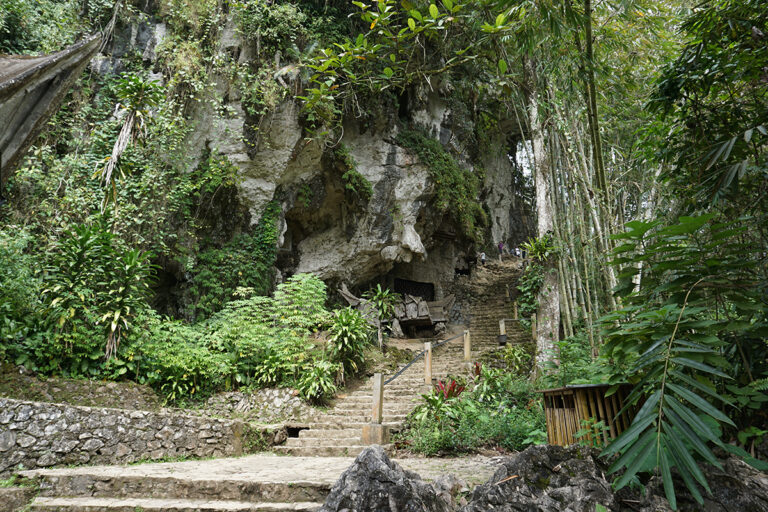
This burial site has existed for 500 years. What makes this site unique is how they use cliffs and caves as burial sites. Following the stairs, you will find an old coffin along the way with multiple skeletons above it. You will also find skeletons widely spread at several points along this site, even outside the coffin
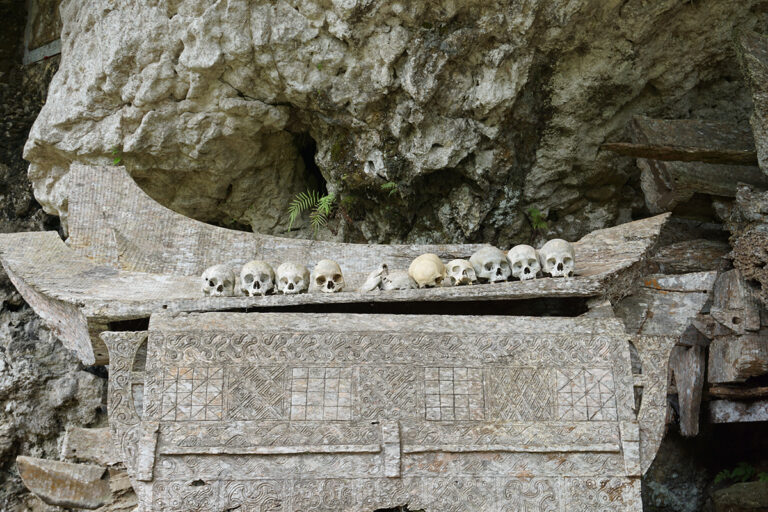
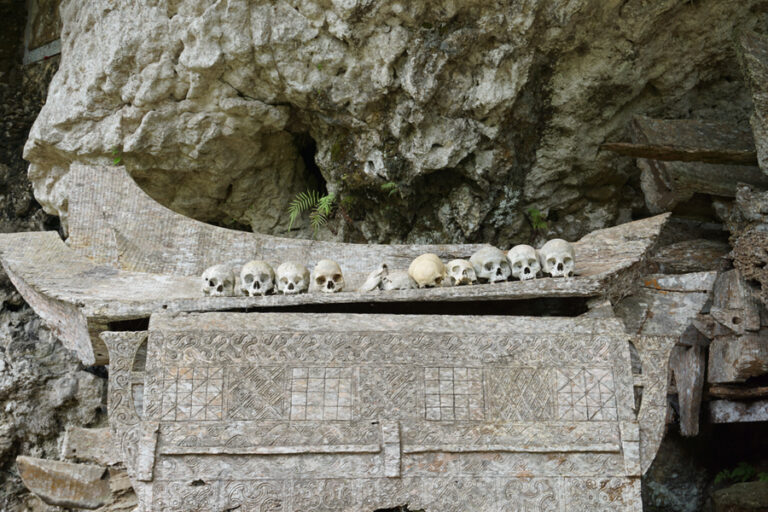
One thing that you need to be aware of is that you can’t touch or move these skeletons, or you will get a local punishment. Please respect the bodies of the deceased if you choose to visit.
Londa
The next gravesite that you should visit in Toraja is Londa. In Londa, most of the attraction is focused on exploring the gravesite inside the cave. To enter Londa, you need to hire a guide to assist you and give you access to a lantern to explore the cave.
In front of the cave, there is a huge cliff with a lot of slits and a wooden platform to support the coffins there. It is quite scary to imagine how if the wooden platform becomes unstable or the coffin rots, it will fall off the cliff. My guide tells me that they will replace the coffin and the clothes of the corpse with new ones if it rots, but they will need to conduct the Ma’nene ritual.

Historically, the position of the coffin on the cliff represents the social status of the corpse during its life. For example, aristocrats from the past are higher up on the cliff.
One thing that you will notice as well in Londa is there is a human-shaped wooden doll on the cliff wall. This doll is Tau-tau, representing the face of the deceased Torajan people. When a Torajan person dies, craftsmen will create Tau-tau that has similar facial features to that deceased person.
Entering the cave, you will surround yourself with a similar burial site with a lot of coffins and skeletons widely spread inside the cave. You will also notice a lot of cigarettes close to the skeletons, which are offerings from their family members. Even though there are a lot of coffins and corpses inside the cave, the cave doesn’t have an unpleasant smell.
Another thing that attracted my attention inside the cave was the two skeletons who stand side by side on the floor. The locals call these skeletons “The Torajan Version of Romeo and Juliet.” This story from the past describes a couple that falls in love but doesn’t get blessings from both parents. They decide to commit suicide together so they can live together in the afterworld.
Lemo
We already talk about the Tau Tau doll previously. In Lemo, you will learn more about Tau Tau because this is the place where you can find the craftsmen who create them.
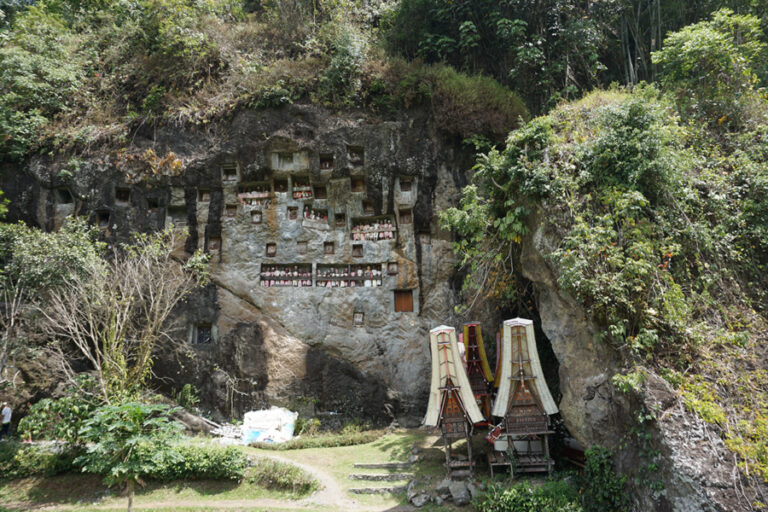
Lemo itself is also a cliff burial site like Londa, but you will not find any coffins there. Instead, Lemo comes in the form of a huge cliff wall with holes in it, and each hole has several Tau Tau there.
Not far from the Lemo site, you will find the Tau Tau local craftsmen with displays of their work collection there.
Kalimbuang Bori
Kalimbuang Bori probably has the most distinctive look compared to the other gravesites. Instead of the form of a cavern or cliff, this site is famous because of its tall-standing rocks, which in the historical term, is called Menhir. Menhir itself is a stone created around 6000 BC that has a funeral function. There are over 100 menhirs standing in Kalimbuang Bori.
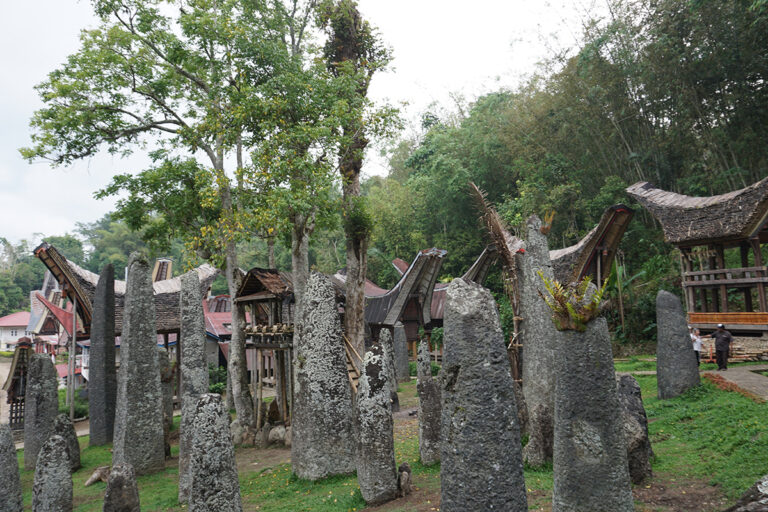
Apart from these menhirs, you can encounter the unique Tongkonan House in this area. This Tongkonan house has more than a thousand buffalo horns on its exterior. Also, there are some gravestones with a boat shape, including some baby graves. In Toraja, they bury babies inside trees.
The complex of Kalimbuang Bori itself is relatively small, so you can navigate the area in just under an hour.
Day 2
Lolai Totombi
Toraja has multiple spots for a good view of the sunrise. The most famous one is Lolai Totombi, which is located around 12 km away from the town of Rantepao. Local people call Lolai “The Country Above the Cloud” and you can expect the view of a sea of clouds covering the Toraja, since the elevation of Lolai is higher than Rantepao. However, getting the perfect “Country Above the Cloud” really depends on your luck, as it’s hard to predict the weather. So, you may not get a clear sunrise with a view of the sea of clouds. But if you’re lucky, the view is really stunning.
I started my day driving a motorcycle at 3:30 AM, passing through the dark and quiet forest along the way. So, if you’re following the same steps that I did, you should really pay attention when driving at this time, because you’ll be driving in little to no light. The alternative to this is that you can try staying at Lolai the previous night.
There are many other spots for sunrise spotting in Lolai. I chose the Totombi spot because it was the closest one, and was the first spot that I saw after my drive. In Totombi, there are multiple huts available, so as I mentioned before, you can stay here the previous night if you don’t want to drive through the dark forest. If you want a higher viewpoint, then you should continue your drive for around 10 minutes and visit Lolai Tongkonan Lempe.
Ollon Hill
I would recommend you give a spare full day for visiting Ollon Hill. Ollon Hill has located just 30 km from Rantepao but with the rough terrain and the place utterly remote, expect to spend at minimum 3 hours for a one-way trip. Since it is located in a pretty outcast area, the landscape here is practically the most beautiful and picturesque landscape that I had seen so far.
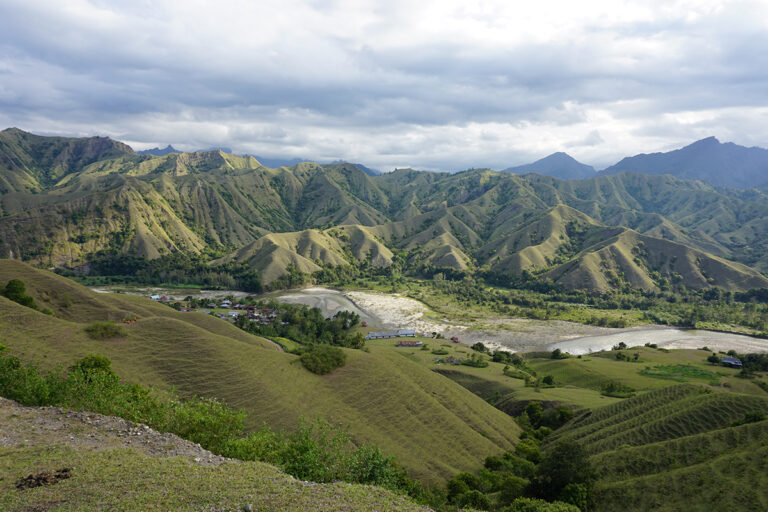
I suggest you find a local trip organizer or local people that can pick you up to go to the hill because it is pretty challenging to navigate it by yourself. Don’t forget to store your amenities such as food and drink, as you will hardly find any supermarket along your way to Ollon.
The last 10km of the journey is probably the toughest. With the road fully covered with rock as well as some of the parts submerged by the shallow river, it is recommended to find a tour guide that can transport you with a trail car or motorcycle which can help make the journey smoother.
On the other note, you may build a camp here and enjoy the night view from these untouched savanna hills.
Trying Torajan Coffee
Any visit to Toraja is not complete without trying Torajan Coffee. If you’re talking about Indonesian Coffee, Torajan Coffee is at the top of the list. Because Toraja is in a mountainous area, there are a lot of coffee plantations there. Because the coffee is planted alongside the spices vegetation, Torajan Coffee has a tempting and delicious smell. You can find a local coffee shop in the town. Don’t forget to buy a bag of either grounded coffee or whole bean coffee before you’re going back to your home country, so you can always sip a cup of Torajan coffee wherever you are.
Conclusion
There you have it: a two-day itinerary travelling Toraja. With this guide, I hope you will get the best experience in Toraja and surround yourself with the authentic culture and abundance of natural beauty.
[ad_2]
Source link